50+ AI Replacing Jobs Statistics 2024

A Forbes Advisor Survey undertaken in 2023 found that 77% of respondents were “concerned” that AI will cause job loss within the next 12 months, with 44% “very concerned”. However, this level of opinion is not conclusive for all workers. Another survey by Jitterbit reports that 85% of office workers believe AI will help to enhance their roles rather than replace them.
So, are jobs really at risk of being replaced by AI on a large scale? To find out more, AIPRM has compiled over 50 AI statistics on job displacement as a result of AI usage, which jobs appear safe, and the impact across different industries.
Top AI replacing jobs statistics #
- Three in 10 (30%) US workers are concerned that they may be replaced by AI
- Seven in 10 (71%) US workers are worried that AI may impact human resources decision-making
- More than a third (37%) of companies say AI replaced certain workers’ jobs in 2023
- 83% of companies say demonstrating AI skills can help employees retain their jobs
- Eight out of 10 women in the US workforce are in occupations ‘highly exposed’ to generative AI automation, compared to three out of five men
- The National Library of Healthcare believes AI could help healthcare professionals work more effectively by cutting down on administrative tasks
- Over the year to November 2023, English-language job adverts on LinkedIn mentioning ChatGPT or GPT saw a 21x increase
- The World Economic Forum cites agriculture, logistics, and teaching as industries that appear safe from AI replacement
How will AI affect the job market? #
According to research from the Heldrich Center for Workforce Development (November 2023), three in 10 (30%) US workers are ‘very’ or ‘somewhat’ concerned that their jobs may be eliminated by AI.
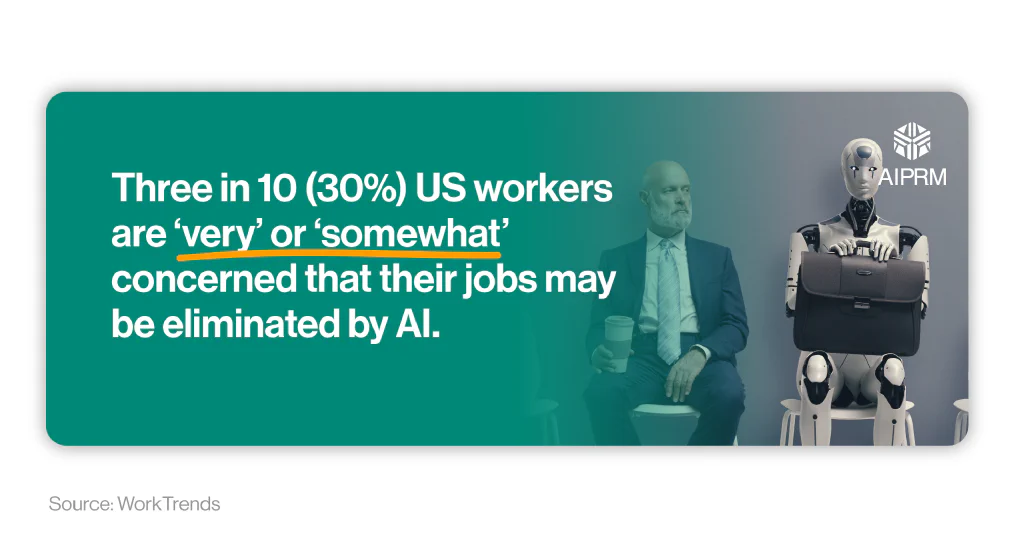
These worries aren’t limited to just the possibility of AI job loss either. Seven in 10 (71%) US workers are concerned that AI may be utilized by employers in human resources decision-making, such as for promotions. This indicates that workers are worried that AI may impact their ability to rise up the ranks in the job market.
AI job loss predictions #
The National Bureau of Economic Research reported that between 50% and 70% of changes to US wages since 1980 can be attributed to the relative wage decline of blue-collar workers, whose jobs have been either degraded or replaced altogether by automation.
Following this line of research, it appears likely that this pattern may increase as we enter an altogether new stage of automation. In fact, in 2023, investment bank Goldman Sachs predicted that 300 million jobs across the United States and Europe could be lost or degraded as a result of AI adoption.

However, these predictions rarely tell the whole story. A survey of 750 business leaders by Resume Builder reported that more than a third (37%) of companies using AI say that the technology replaced workers in their organization in 2023 because “they were no longer needed”.
Moreover, in 2024, 44% who use AI or plan to by next year say that employees will “definitely” (21%) or “probably” (23%) be laid off due to artificial intelligence.
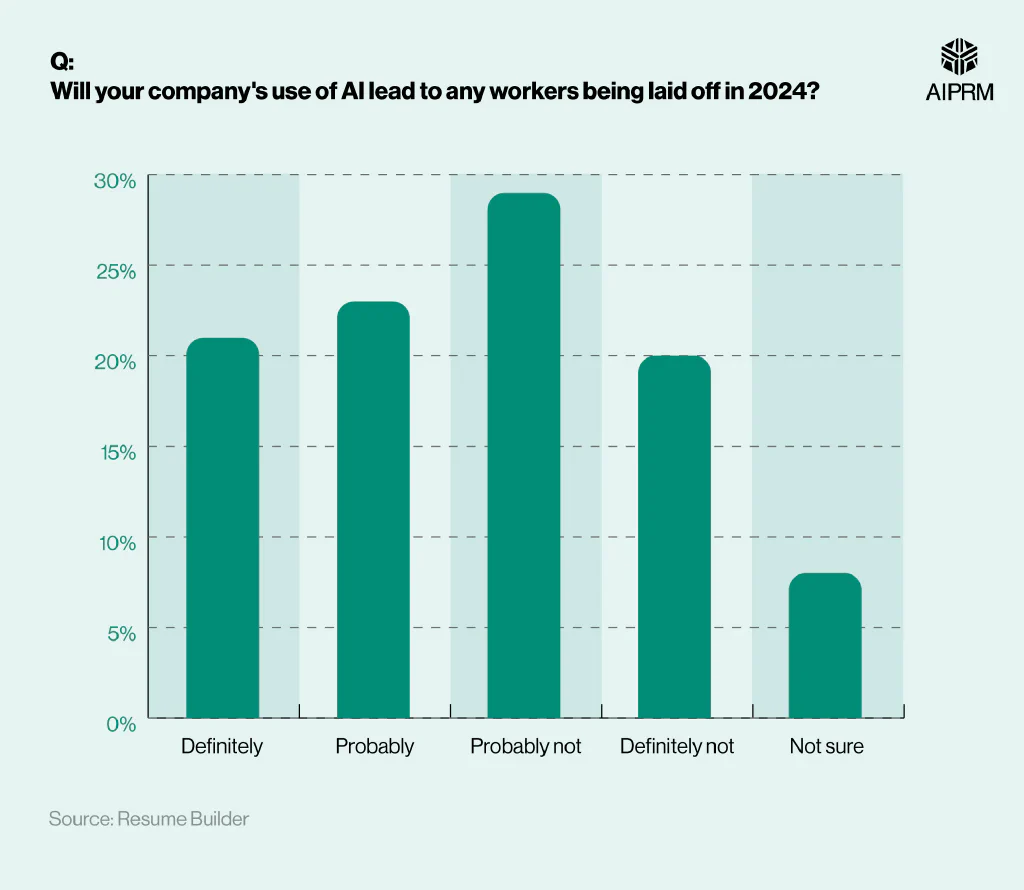
Despite this, 91% of companies using or planning to use AI in 2024 will hire new employees in 2025, and 96% state that having AI skills will be beneficial for candidates to have hands-on experience working with artificial intelligence.
A further 83% say demonstrating AI skills will help current employees have more job security than those who don’t. Workers willing to adapt to technology demands and sharpen up on AI tools may be able to mitigate the impact of these job loss predictions.
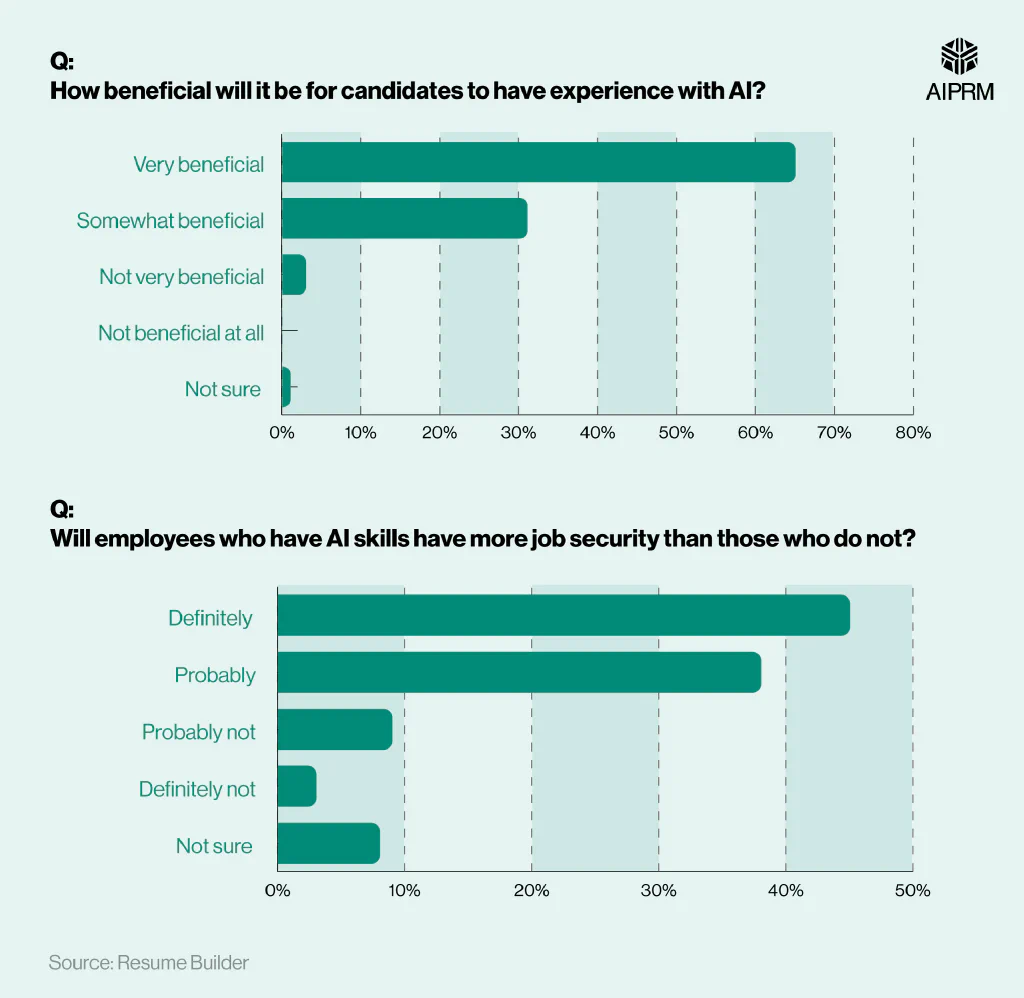
Are men or women more vulnerable to AI-related job loss? #
Analysis by the Kenan Institute of Private Enterprise found that eight out of 10 women (58.87 million) in the US workforce are in occupations highly exposed to generative AI automation, compared to six out of 10 men (48.62 million). This means that 21% more women than men in the US workforce are exposed to AI automation.

This is likely a result of the distribution of genders between white and blue-collar jobs. While women make up 70% and 30% in these areas, respectively, men are more evenly distributed (roughly 50/50).
This is based on data from Goldman Sachs on the 15 occupations most vulnerable to replacement by generative AI — a technology that teaches AI systems to create content independently. ‘Highly exposed’ constitutes a level where a quarter to half (25-50%) of tasks in this occupation could be automated by generative AI.
Job displacement due to AI: Will AI replace human jobs? #
Artificial intelligence replacing healthcare jobs #
Of the six industries evaluated for their rate of generative AI adoption by Fishbowl, the healthcare industry has the lowest uptake, at 15%. This is less than half the adoption rate of marketing and advertising (37%).
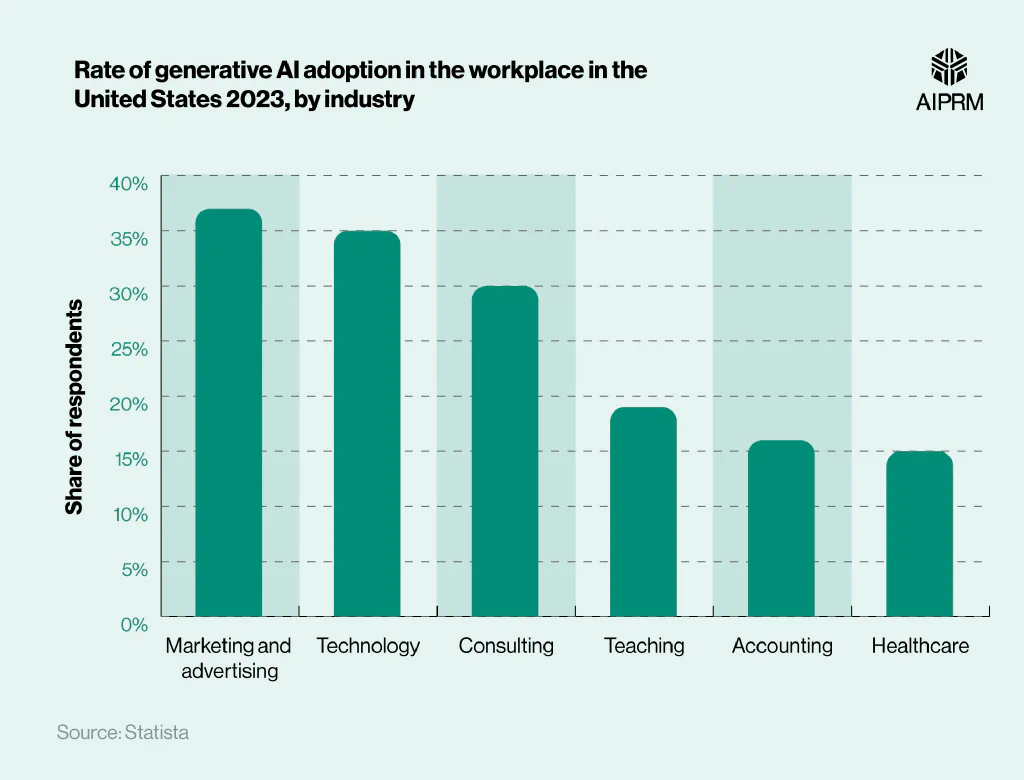
The National Library of Healthcare stated that the role of AI in healthcare will “complement” rather than replace doctors and healthcare providers.
Forbes supports this view, stating that AI will be able to help offload the time-consuming administrative tasks required in healthcare. A study from the Mayo Clinic points out that doctors spend half of their working day completing administrative work, such as updating patient records and scheduling appointments – tasks that can be filled by generative AI.
Read more about AI in healthcare statistics.
Artificial intelligence replacing jobs in the creative industry #
With Goldman Sachs’ research suggesting that generative AI has the potential to automate a quarter (26%) of tasks in arts, media, and entertainment, AI is of particular concern in the creative sector.
The American Federation of Television and Radio Artists undertook a near-four-month strike in 2023, with the proposed use of AI in the industry as one of the driving factors. A particular concern was the use of generative AI to replace the roles of extras on set.
According to data from the Harris Poll, almost three-fifths of US adults think content created by generative AI is less impressive than that made by a human, and 44% think it’s easy to tell the difference between the two.
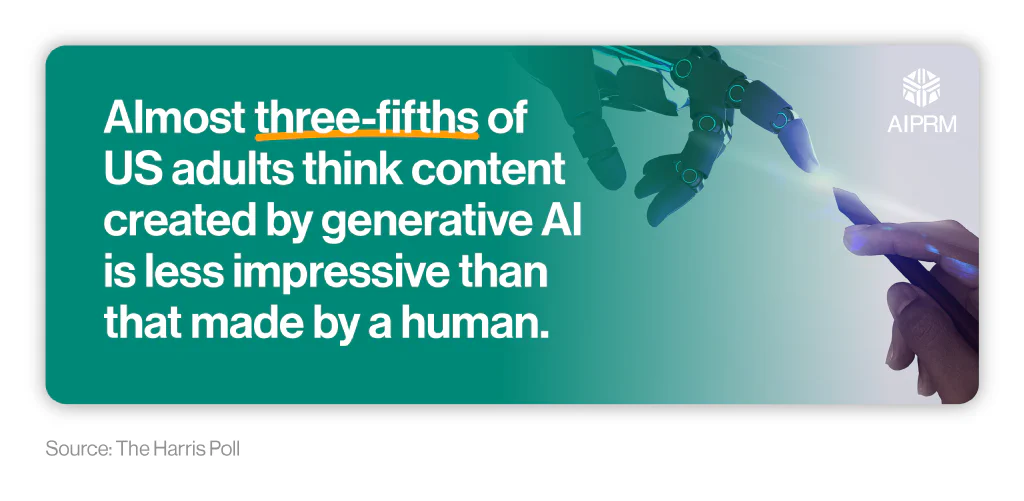
Analysis from the poll argues for reframing how we view the use of this technology in the creative industry, stating it should be seen as a tool for professionals, rather than a competitor. When viewed this way, public opinion changes, with only 15% of adults against creators using AI to assist in content creation, and even fewer (12%) against companies making use of it.
Artificial intelligence replacing jobs in the customer service industry #
Customer-facing jobs are notoriously stressful, with Nextiva reporting that call center jobs have an average annual turnover rate of 30% in the US, as employees face burnout.
Many experts agree that, rather than replacing these roles, AI can be used to help augment them by automating tasks. In a survey of office workers in the US and UK by Jitterbit, “reducing time spent gathering information from work systems and applications” is one of the top anticipated benefits of AI, allowing more time for “thoughtful work” and “larger projects”.
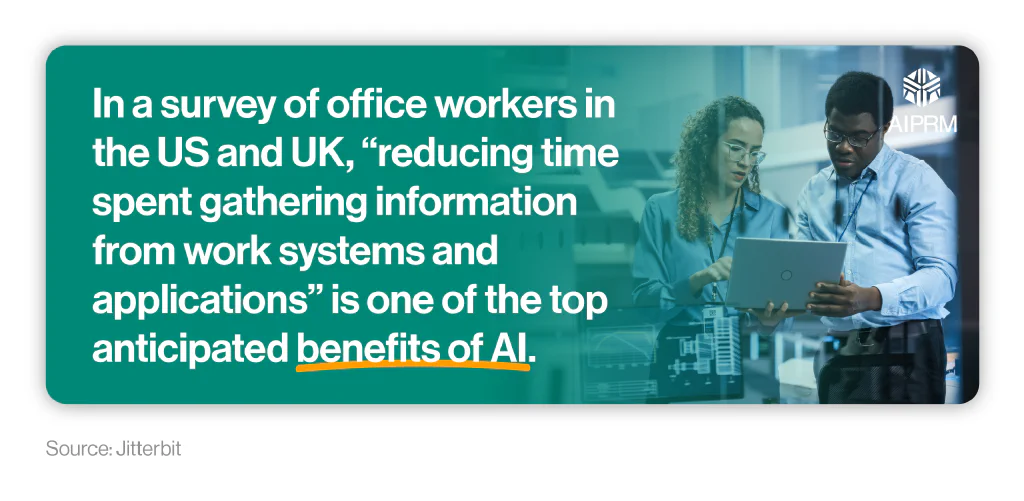
Forbes reports that nearly half (47%) of Gen Z consumers will not return to a brand after a single bad customer service experience; therefore, the inability of AI to replicate human skills such as empathy poses a risk to brand perception.
By automating more menial tasks, customer service agents are better able to handle the human connection side of the industry, which brands hope will reduce employee turnover rates.
This trend of automation has already seen success at Klarna. The financial services provider reports that, in the first month following the launch of its AI assistant, two-thirds of customer service chats have been automated, with similar customer satisfaction levels recorded.
What jobs will AI create? #
While certain jobs are likely to be replaced by some type of AI automation, the history of technology in the workplace indicates that new developments also lead to job creation.
In fact, the founder of the World Economic Forum, Klaus Schwab, dubbed this process the ‘Fourth Industrial Revolution.’
Are workers looking for AI-related jobs? #
LinkedIn has reported that, between December 2022 and September 2023, conversations around AI in the business and employment workspace increased by 70%. These conversations are largely driven by male millennials.
Men account for 58% of these conversations, compared to 31% of women. Meanwhile, millennials account for nearly half (45%), followed by Gen Z (26%), Gen X (21%), and finally, Boomers (4%).
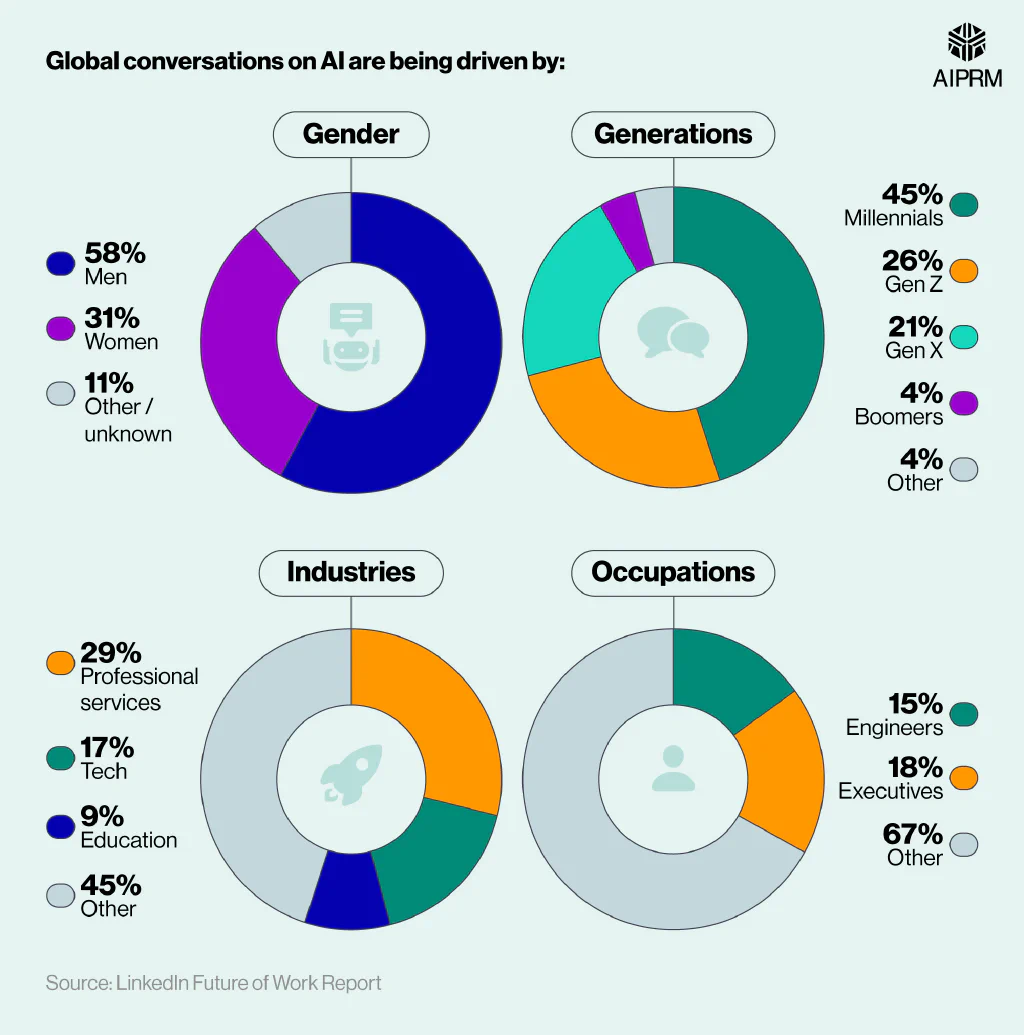
Also during this period, LinkedIn noted that views for AI-based and related jobs increased by 12% across seven major economies: Australia, Brazil, France, Germany, India, the UK, and the US. Actual applications have seen a similar increase, at 11%.
Interest in AI-based and related jobs is highest in the United States, with a 21% increase in advert views, and a 19% increase in applications. Over the year to November 2023, English-language job adverts on LinkedIn mentioning ChatGPT or GPT saw a 21x increase.
New job opportunities created by AI #
In 2013, Oxford economists Carl Benedikt Frey and Michael Osborne estimated that nearly half (47%) of all jobs in the US workforce could be replaced by AI, arguing that this automation would be focused on “low skill, low income” jobs.
Despite reaffirming this belief in 2023, Frey has now also stated that job replacement is “not the right way” to think about the job market. Instead, “more competition” is one of the biggest challenges in the workplace, as more people have access to tools such as ChatGPT, allowing a wider group of people to create high-quality work.
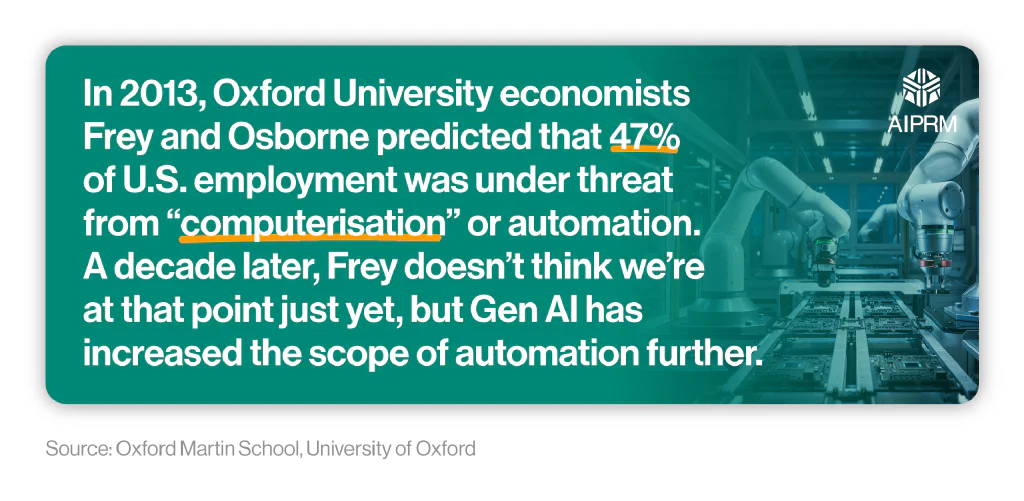
Therefore, rather than considering automation to be a threat to job security, AI adoption should be seen as a gateway to “democratization and competition.” As a wider pool of people are given access to AI tools, Frey believes that more roles will become available and wages will decrease as a result.
What jobs will AI not replace? #
Whilst AI has enormous capabilities, certain skills simply cannot be replicated by machines: leadership, emotional intelligence, and nuanced communication are just some of these.
This is not to mention that AI cannot replace certain manual labor jobs. In fact, industry expectations of machines replacing manual and physical work have decreased.
Companies surveyed for the World Economic Forum’s ‘Future of Jobs’ report in 2020 anticipated that 47% of these tasks could be automated by 2025, whilst the 2023 report indicates a revised estimate of 42% automation by 2027.
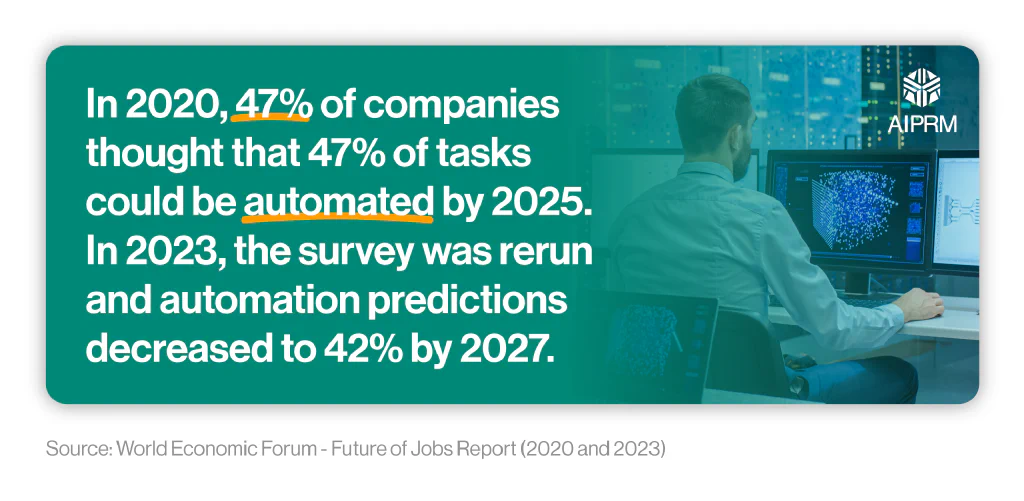
Data on the projected increase in job growth across certain industries can be indicative of the shortfall of AI in these areas.
Agriculture #
The World Economic Forum has predicted a 30% increase in professional agricultural roles by 2028, equal to 30 million jobs.
This job growth is due to the expected impact of shorter supply chains (as smaller farms sell directly to consumers) combined with the need for in-person manual labor. This indicates that AI will not be able to fill the increased demand in agriculture.
Teaching #
By 2027, the World Economic Forum predicts three million new jobs will have been created in vocational and higher education (growth of 10%).
As these roles rely on skills such as empathy, active listening, leadership, and social influence, it is unlikely AI will be able to fill these roles, as these are uniquely human attributes.
Logistics #
As with the agricultural industry, the market shift to localized supply chains is expected to drive an increase of 2.5 million jobs in the supply chain and logistics sector.
The World Economic Forum cites low expectations on the impact of autonomous drivers as evidence that these jobs are unlikely to be replaced by AI in the near future.
AI replacing jobs FAQs #
Will AI take my job?
Although the integration of AI boasts a huge myriad of opportunities in the workplace, many employers are viewing the tool as an ‘add-on’ to current roles, rather than a replacement.
The World Economic Forum has predicted that, though 85 million jobs may be set to be replaced, 97 million new jobs are also likely to be created by the ‘AI Revolution,’ dubbing this joint trend ‘automation and augmentation.’
In this vein, LinkedIn reported a 12% increase in adverts for AI-based and related jobs across seven major economies between December 2022 and September 2023, indicating that companies are already following this trend of adapting existing jobs to include AI skills.
How many jobs will AI replace?
Investment bank Goldman Sachs predicted in 2023 that as many as 300 million jobs could be replaced by AI, particularly those focused on administrative tasks.
However, reports from other businesses suggest this prediction is unlikely to materialize, instead arguing AI will lead to job adaptation, rather than replacement. Nine in 10 companies planning to use AI in 2024 stated that they were likely to hire more workers as a result of this, with 96% favoring candidates who can demonstrate hands-on experience working with AI.
When will AI take over jobs?
Despite numerous organizations each offering their own predictions of when the AI revolution will reach its apex, we are also witnessing these forecasts being constantly revised.
Companies interviewed for the World Economic Forum’s 2020 ‘Future of Jobs’ report anticipated that 47% of manual labor jobs could be automated by 2025, but by 2023’s report this prediction had already been reduced to 42% automation by 2027.
These revisions indicate that it is impossible to say when AI will take over large swathes of the workforce, in any definitive sense.
How will AI affect the job market?
Although it is difficult to discuss displacement in the job market in terms of hard numbers, research is better able to discuss the impact of AI on the market with regards to who appears most vulnerable.
The Kenan Institute of Private Enterprise found that eight out of 10 women (58.87 million) in the US workforce are in occupations highly exposed to generative AI automation, compared to six out of 10 men (48.62 million). This research indicates that US women are at a higher risk of job insecurity as a result of AI development.
Moreover, although LinkedIn has reported an increase in AI-related conversations on site, far more men are fuelling this conversation than women (58% vs 31%, respectively).
Will AI take my job?
Although the integration of AI boasts a huge myriad of opportunities in the workplace, many employers are viewing the tool as an ‘add-on’ to current roles, rather than a replacement.
The World Economic Forum has predicted that, though 85 million jobs may be set to be replaced, 97 million new jobs are also likely to be created by the ‘AI Revolution,’ dubbing this joint trend ‘automation and augmentation.’
In this vein, LinkedIn reported a 12% increase in adverts for AI-based and related jobs across seven major economies between December 2022 and September 2023, indicating that companies are already following this trend of adapting existing jobs to include AI skills.
How many jobs will AI replace?
Investment bank Goldman Sachs predicted in 2023 that as many as 300 million jobs could be replaced by AI, particularly those focused on administrative tasks.
However, reports from other businesses suggest this prediction is unlikely to materialize, instead arguing AI will lead to job adaptation, rather than replacement. Nine in 10 companies planning to use AI in 2024 stated that they were likely to hire more workers as a result of this, with 96% favoring candidates who can demonstrate hands-on experience working with AI.
When will AI take over jobs?
Despite numerous organizations each offering their own predictions of when the AI revolution will reach its apex, we are also witnessing these forecasts being constantly revised.
Companies interviewed for the World Economic Forum’s 2020 ‘Future of Jobs’ report anticipated that 47% of manual labor jobs could be automated by 2025, but by 2023’s report this prediction had already been reduced to 42% automation by 2027.
These revisions indicate that it is impossible to say when AI will take over large swathes of the workforce, in any definitive sense.
How will AI affect the job market?
Although it is difficult to discuss displacement in the job market in terms of hard numbers, research is better able to discuss the impact of AI on the market with regards to who appears most vulnerable.
The Kenan Institute of Private Enterprise found that eight out of 10 women (58.87 million) in the US workforce are in occupations highly exposed to generative AI automation, compared to six out of 10 men (48.62 million). This research indicates that US women are at a higher risk of job insecurity as a result of AI development.
Moreover, although LinkedIn has reported an increase in AI-related conversations on site, far more men are fuelling this conversation than women (58% vs 31%, respectively).
Glossary #
Deep learning #
This element of AI imitates the information processing of the human brain. Rather than using algorithms which perform only one task, this type of machine learning can learn from unstructured data without human supervision.
Generative AI #
This technology trains an AI system using large datasets, allowing it to recognise patterns and structures. The system can then create new content alone, including images, text, and code.
Large language model (LLM) #
Usually referred to as an LLM, this system is trained on large sets of text, allowing it to understand language and generate human-like text.
Machine Learning #
This type of learning focuses on developing algorithms and models that in turn help machines predict trends and behaviors from large datasets, without human intervention. It works with elements of coding, computer science, and mathematics.
Turing test #
This test, created by 20th century mathematician and computer scientist Alan Turing, aims to evaluate a machine’s ability to exhibit intelligence on an equal level to humans - particularly in terms of language and behavior.
A human evaluator compares a conversation between a human and a machine, and if they are unable to determine which is which, the machine passes the Turing test.
Sources #
https://www.forbes.com/advisor/business/artificial-intelligence-consumer-sentiment/
https://www.nber.org/papers/w28920
https://www.resumebuilder.com/1-in-3-companies-will-replace-employees-with-ai-in-2024/
https://www.statista.com/statistics/1361251/generative-ai-adoption-rate-at-work-by-industry-us/
https://www.ncbi.nlm.nih.gov/pmc/articles/PMC10328041/
https://www.sciencedirect.com/science/article/pii/S0025619618309388?via=ihub
https://theharrispoll.com/briefs/generative-ai-jobs/
https://economicgraph.linkedin.com/research/future-of-work-report-ai
https://oms-www.files.svdcdn.com/production/downloads/academic/The_Future_of_Employment.pdf
https://fortune.com/2023/02/07/chatgpt-economist-says-disrupt-job-market-lower-wages-ai/
https://www.weforum.org/agenda/2023/05/jobs-ai-cant-replace/